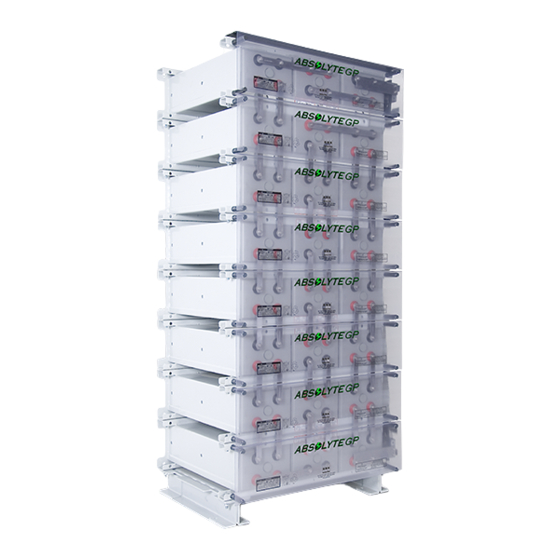
Publicidad
Idiomas disponibles
Idiomas disponibles
Enlaces rápidos
A Division of Exide Technologies
1.0 Safety Precautions
1.1 Batteries contain sulfuric acid which can cause burns and other serious injury. In the event of contact with sulfuric
acid, flush immediately and thoroughly with water. Wear safety goggles, rubber apron, and rubber gloves.
1.2 Batteries can generate explosive gasses, which when released, can explode and cause serious injury. Keep sparks,
flames, and smoking materials away from the battery area.
1.3 Multi-cell systems attain high voltages, therefore, extreme caution must be exercised during installation of a battery
system. Interrupt the AC and DC circuits before working on batteries or charging equipment.
2.0 Storage
2.1 Batteries shall be stored indoors in a cool (less than 25°C (77°F)), clean and dry location. The storage interval
shall not exceed six (6) months, unless the battery receives an equalize charge within (6) months and every
six (6) months thereafter as long as it remains in storage. Elevated temperatures (>25°C) will result in higher
rates of self-discharge and require shorter charging intervals. Refer to I/O Manual, Section 92.61.
3.0 Charging (constant voltage only)
3.1 Initial and Equalize Charge. See table below for charge voltages and times for initial charge and equalize charge
(see I/O manual for conditions that may necessitate an equalize charge). Charge voltage may be limited by system
equipment. Determine the maximum volts that may be applied to the system equipment. This voltage, divided by the
number of cells connected in series, will establish the maximum volts per cell (VPC) that are available.
CELLS VOLTS TIME-HRS
2.30
2.35
3.2 Time periods listed are for 77°F (25°C). For other temperatures a compensation factor of 0.003 V/°F (0.0055
V/°C) per cell is recommended. Do not compensate higher than 2.35 VPC or lower than 2.20 VPC. Raise the
voltage to the appropriate value. When charging current has tapered and stabilized (no reduction for three
hours), charge for the hours shown in the above table or until the lowest cell voltage ceases to rise.
3.3 Float Charge. Recommended float voltage is 2.23 - 2.27 at 77°F. For other temperatures a compensation factor of
0.003V/°F (0.0055V/°C) per cell is recommended. Do not compensate higher than 2.35VPC or lower than 2.20VPC.
3.4 Operation of Absolyte cells at an average annual temperature above 77°F (25°C) and float voltages higher than
those recommended will result in a reduction of life. Absolyte batteries should never be operated above 122°F
(50°C).
4.0 Connector Torque
4.1 Torque all terminal and intercell connections to 100 inch-lb at least once a year.
5.0 Inspection / Records
5.1 Monthly - Record battery terminal voltage, ambient temperature, pilot cell voltage.
5.2* Annually - Retorque connections, record battery terminal voltage, ambient temperature, individual cell voltages.
GB3917 2010-12 (Z66ABS1PIO)
BASIC OPERATING AND MAINTENANCE INSTRUCTIONS
FOR ABSOLYTE
(See I/O Manual, Section 92.61, for detailed instructions)
When charging current has tapered and stabilized (no further reduction for three hours),
24
charge for the number of hours in the table to the left or until the lowest cell voltage ceases
to rise. To determine the lowest cell, monitoring should be performed during the final 10% of
12
the charge time.
*(Minimum requirements for warranty purposes.)
BATTERIES
®
GNB
Industrial Power, a division of Exide Technologie
®
Publicidad

Resumen de contenidos para GNB ABSOLYTE
- Página 1 0.003V/°F (0.0055V/°C) per cell is recommended. Do not compensate higher than 2.35VPC or lower than 2.20VPC. 3.4 Operation of Absolyte cells at an average annual temperature above 77°F (25°C) and float voltages higher than those recommended will result in a reduction of life. Absolyte batteries should never be operated above 122°F (50°C).
- Página 2 2.20 VPC. 3.4 Operar las celdas Absolyte a una temperatura anual promedio superior a los 77°F (25°C) y con voltajes de flotación superiores a los recomendados reducirá la vida útil. Las baterías Absolyte no se deben operar nunca por encima de los 122°F (50°C).